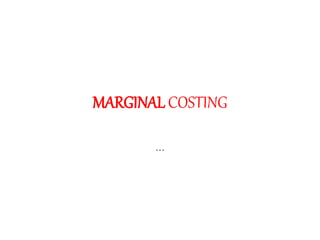
Marginal costing
- 2. TOTAL COST • COST CAN BE CLASSIFIED IN TO FIXED AND VARIABLE • The cost which vary directly in relation to the volume of output is called variable cost • The cost which remain constant or unaffected by the change in volume of production is called fixed cost. • it is always uncontrollable so it does not consider management for decision making. Or it is not relevant
- 3. meaning • It is the additional cost of producing an additional unit. It is the cost of the last unit produced. • Definition • ICMA LONDON defines MC as the amount at any given volume of output by which aggregate costs are changed if the volume of output is increased or decreased by one unit • It is the total cost changes when there is a change in output by one unit.
- 4. .. • Eg. if the total cost of producing 100 unit is Rs. 10,000 and cost for 101 is Rs. 10,050, so the MC of producing an additional unit will be Rs. 50 • So Mc is the cost of one more or one less unit produced than the existing level of production. • Mc is also called as variable cost. Because an increase in 1 unit of production will increase in variable cost only. • Mc= Direct Material cost+ Direct Labour cost+ Direct Expenses + Variable overheads. • Or mc= Prime cost plus variable overheads
- 5. Marginal costing • It is a technique of ascertaining cost whereby marginal costs are ascertained. • Here only variable costs are charged to cost unit • Fixed cost are charged to a fund called contribution. • Marginal costing is the ascertianment by differentiating between fixed costs and variable costs, of marginal cost and of the effect on profit of changes in volume or type of output.
- 6. Features of Marginal costing • it is not a method of costing. It is only a technique for managerial decision making • All costs are classified in to fixed and variable • Fixed cost charged against profit • Variable cost only charged to product • The stock of finished products and work in progress are valued at marginal cost • Selling price equal to variable cost + contribution
- 7. Absorption costing • Here both costs are taken. it is also known as full cost or total cost techniques. It is a conventional technique. • Definition It is a technique whereby fixed as well as variable costs are allotted to cost units. ICMA London
- 8. Limitation of absorption costing • A portion of FC is carried over to subsequent accounting period as part of closing stock. So not as per accounting period concept • It depends on levels of output which may vary from period to period. Due to existence of fixed cost, cost per unit may change. • Not suitable for managerial decision making(i.e. Buy or make decision, product mix, selection of best alternatives ) • Does not help in preparing flexible budget, tender, quotation etc • Not suit for planning or controlling cost.
- 9. ABSORPTION COSTING VS MARGINAL COSTING BASIS ABSORPTION COSTING MARGINAL COSTING 1. CHARGING OF COST ALL COSTS ARE CHARGED ONLY VARIABLE COST 2. STOCK VALUATION TOTAL COST MARGINAL COST 3. BASIS OF DECISION PROFIT CONTRIBUTION 4. SUITABILITY EXTERNAL REPORTING INTERNAL REPORTING 5. EFFECT OF COST PER PRODUCTION INCREASE UNIT COST PER UNIT REDUCES COST PER UNIT REMAIN SAME AT ALL LEVELS OF PRODUCTION 6. PURPOSE LONG TERM PRICE POLICY AND COST PLANNING, CONTROLLING AND DECISION MAKING IN SHORT RUN 7. EMPHASIS PRODUCTION SELLING AND PRICING ASPECTS
- 10. DIRECT COSTING TECHNIQUES • HERE ONLY DIRECT COST ARE TAKEN TO CALCULATE THE COST OF PRODUCT. THAT IS WHETHER FIXED OR VARIABLE ARE TAKEN HERE • WHILE IN MARGINAL COSTING ONLY VARIABLE COSTS ARE CHARGED TO PRODUCT.FIXED COSTS ARE COMPLETELY IGNORED.
- 11. ASSUMPTIONS OF MARGINAL COSTING • 1. all cost are divided in to fixed and variable • 2. fixed cost remain constant at all levels of activity • 3. variable cost vary but unit cost will not vary • 4. selling price remains same • 5.Price of material, rates of labour etc constant • 6.Volume of production only influence costs • 7.There is no stock
- 12. Dis advantages of marginal costing • 1. Difficulty in separation – cost • 2. Difficulty in application- fixed assets oriented business • 3. Under valuation of stock- no fixed cost element • 4. True only in short period • 5. Time factor is completely ignored- two jobs • 6.More emphasis on sales- production equally important • 7. Wrong basis for pricing- not contribution alone
